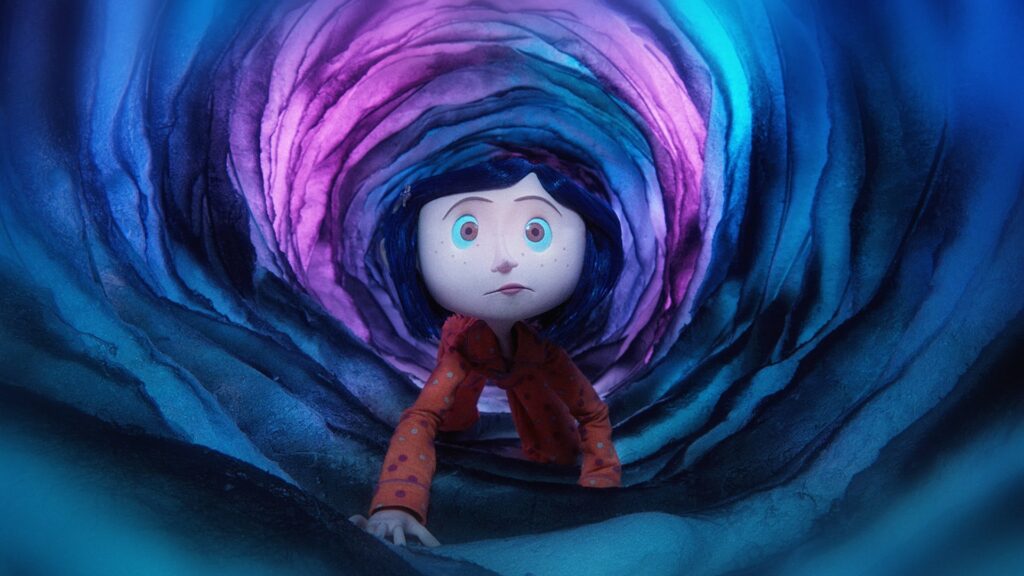For September, Horror Press wanted to look into the world of gateway horror. Those films that can capture the hearts of young filmgoers or those who get into horror at a later age. There are a plethora of films that fall under the category of ‘gateway’ horror, but what are they? To start, it felt important to look at an animated horror film loved by genre fans of all ages. Even though stop-motion, claymation, and animation films don’t do the trick for me, there’s no getting around the fact Coraline is a truly impressive film. (Author’s note: after getting into the process of writing this, and realizing who wrote the source material, there’s quite a sour taste in my mouth.)
After moving to a new secluded house, with a whacky cast of characters, Coraline (Dakota Fanning) finds herself isolated and [seemingly] on her own. On one particularly drab day, Coraline is transported to a magical world, where she is the star. Her new parents pay attention to her, and Wybie (Robert Bailey Jr.) joins her in her adventures; things seem too good to be true. And they are! Coraline soon finds herself in a battle of life and death. Or is this all just a figment of her overactive and isolated imagination?
Coraline is fascinating in a myriad of ways. It can be straightforwardly viewed and taken at face value or dissected frame by frame to reveal Coraline may be in a simulation! I say that as a lark, but there are countless theory videos on Coraline, including one that posits the question of a possible simulation. Many people, much smarter than me, have dug their master’s degree and doctorate brains into the spiderweb of theories that lurk below the surface. While I don’t have any groundbreaking new theories for Coraline, I do think it can be dissected as a gateway horror film.
The biggest idea that comes forth in Coraline is the idea of perspective. Coraline finds herself longing for a connection of any sort. She’s forced to move to this new decrepit house. The walls are bare and in disrepair, her parents are working on individual projects, and Coraline is tasked with *checks notes* counting the windows. It’s easy to understand why Coraline is frustrated with her current lot in life. Though as someone who grew up with parents who advocated for a “back when the streetlights turn on” type of childhood, part of me is jealous that Coraline didn’t explore the wooded areas around her house. But that point is moot.
By the finale, after Coraline has conquered The Bedlam/The Other Mother (Teri Hatcher), she’s transported back to her world where things seem to be better. Whether or not what Coraline went through is real doesn’t matter. What matters is the lesson(s) she learned along the way. The main lesson is perspective. Things aren’t necessarily better by the film’s end, but it’s how Coraline perceives the world. Throughout Coraline, she is completely all about herself. Everything must revolve around her and what she wants. It’s not until her triumph over evil, refusing to conform with the button-eyes, that she realizes other people matter, too.
Coraline is visually appealing in a way no stop-motion film has been for me before. It balances the visual horror with whimsy and charm. One of my favorite aspects is how a film like this appeals to such a wide array of demographics. I didn’t stumble upon this movie until about two years ago and I was truly upset I hadn’t seen it in 2009. Would it have changed my life if I did? Probably not. But something like Coraline would have piqued my interest to dive into more stop-motion horror films.
If you want to introduce a younger family member to horror, Coraline is a must-watch film. It’s not too childish in any aspect, but it still works as a film for kids. Very few films can do both and succeed. The films that do must be held in high regard, and Coraline is a one-of-a-kind film.
Hopefully, the Neil Gaiman stuff doesn’t tarnish the legacy of it.
